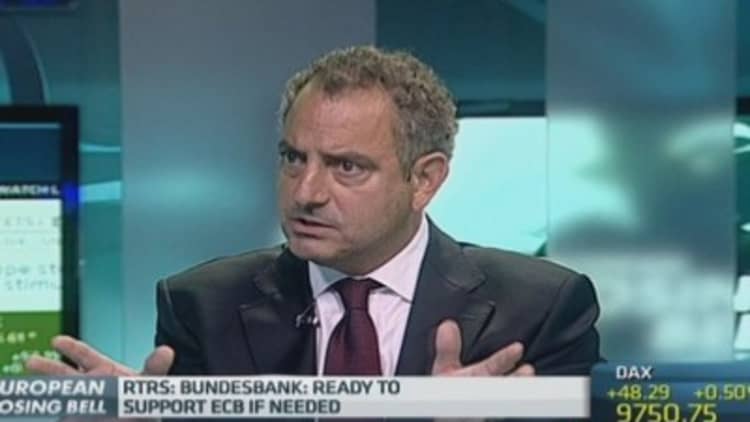
European bond funds likely continued to outperform in April, according to data out this week, despite ongoing concerns about when the U.S. will hike base rates and whether the euro zone will instigate bond purchases to boost prices.
Bond funds were the top-performing European funds in March, attracting estimated net inflows of 21.5 billion euros ($29.6 billion), data provider Lipper said on Monday. The next top-performers were mixed-asset and equity funds, which attracted inflows of 8.5 billion euros and 3.6 billion euros, while property, alternative/hedge funds and commodity funds all saw net inflows as well.
Read More
In its monthly report on European fund trends, Lipper forecast that bond funds topped equity and other rivals in April as well.
"Looking at Luxembourg- and Ireland-domiciled funds, bond funds—with projected net inflows of around 14.4 billion euros—might be the best selling asset class for April," wrote Detlef Glow, head of EMEA research at Lipper.
U.K. gilts proved popular in March, with the U.K.'s Scottish Widows Gilt Fund the best-performing fund in Europe. It attracted inflows of 5.6 billion euros, boosted by a restructuring of assets in Scottish Widow's life and pension funds, and at Lloyds Bank, its parent company.
The Scottish Widows Gilt fund was also the best-performing fund by sales year-to-date, trouncing rival funds at DNB, M&G and Morgan Stanley.
Benchmark 10-year Gilts have gained 3.3 percent since the start of this year, and yielded 2.73 percent on Tuesday.
Read MoreTrack UK Gilts

A report by consultancy Mercer on Friday suggested that the move into bond funds would continue over the next year, and that Gilts would remain popular.
Of the 1,200 European pension funds it surveyed, 20 percent said they were looking to increase bond allocations, especially to index-linked gilts and corporate bonds. Twenty-eight percent said they were looking to reduce their domestic equity allocations over the next 12 months, and one-quarter said they would reduce non-domestic equity allocations.
Bank of America Merrill Lynch (BAML)'s regular fund manager survey, out on Tuesday, suggested global investors had already started pulling out of equities. It said the proportion of investors overweight on equities fell to a net 37 percent in May from 45 percent in April.
Read MoreCash is king again as investors shy from risk: BofA ML
Treasurys
The picture may be less rosy for U.S. Treasurys as well, with analysts warning that shorter-duration notes may sell-off as an end to the zero-base rate era looms. The Treasury yield curve has flattened recently, with 30-year notes gaining 0.21 percent on Tuesday, while and notes traded flat.
Read MoreTrack U.S. Treasury markets

"As quantitative easing comes to an end, there is a risk in the coming months that the short-end of the yield curve could spike," said Anuj Khanna, CEO for South Asia, at Pictet Wealth Management, which oversees around $446 billion in assets.
"If that were to happen, interest rates would rise, which would mean that people borrowing to invest could suffer the double whammy of the borrowing cost going up and the price of bonds going down."
Read MoreCNBC explains: Yield curves

Investors surveyed by BAML also raised concerns about bonds from "peripheral" European countries like Spain, Italy, Greece and Portugal.
"Euro zone periphery debt is seen as the most crowded trade globally," said Obe Ejikeme, European equity and quantitative strategist at BAML, in a report on its recent survey.

